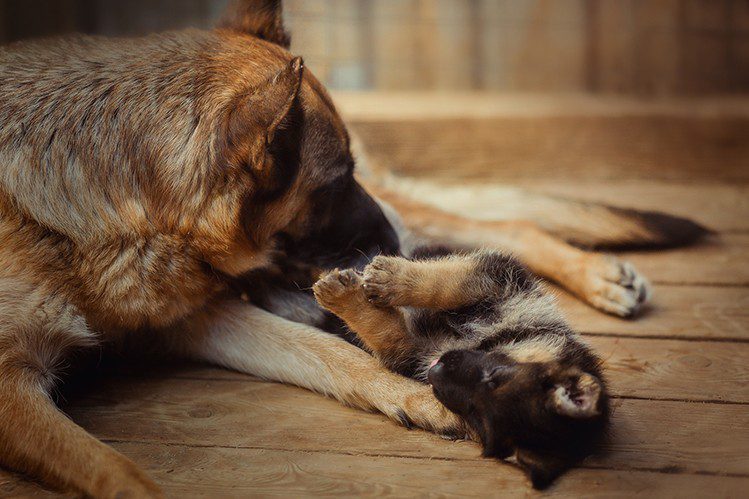
Are pets capable of empathy?
Do you think your dog can feel the suffering of another animal? Does a cat understand when you feel bad? Is she trying to help you? Are animals capable, like humans, of empathy, sympathy, empathy? Let’s talk about it in our article.
In the 16th century, animals were equated with machines. It was believed that only a person can think and experience pain. And animals do not think, do not feel, do not empathize and do not suffer. Rene Descartes argued that the groans and cries of animals are just vibrations in the air that an intelligent person would not pay attention to. Cruelty to animals was the norm.
Today, we recall those times with horror and hug our beloved dog even tighter… It’s good that science is developing rapidly and breaking the old patterns.
Over the past centuries, many serious scientific studies have been carried out that have radically changed the way humans look at animals. Now we know that animals also feel pain, suffer too, and empathize with each other – even if they don’t do it quite like we do.

Does your pet understand you? Ask this question to any loving owner of a cat, dog, ferret or parrot – and he will answer without hesitation: “Of course!”.
And indeed. When you live with a pet side by side for several years, you find a common language with him, you learn his habits. Yes, and the pet itself sensitively responds to the behavior and mood of the owner. When the hostess is sick, the cat comes to treat her with purring and lies down right on the sore spot! If the owner cries, the dog does not run to him with a toy at the ready, but puts his head on his knees and comforts with a devoted look. And how can one doubt their capacity for empathy?
Mutual understanding with a pet is wonderful. But don’t make this common mistake. Most of us tend to project our emotions and feelings onto our pets. They are family members for us, and we humanize them, waiting for a “human” reaction to various events. Unfortunately, sometimes it works to the detriment of pets. For example, if the owner thinks that the cat did things in his slippers “out of spite”, and resorts to punishment. Or when a dog does not want to be sterilized so that it does not lose the “joy of motherhood.”
Unfortunately or fortunately, animals see the world differently than we do. They have their own system of perception of the world, their own peculiarities of thinking, their own reaction schemes. But this does not mean that they do not feel and do not experience. They just do it differently – and we need to learn to accept it.

Remember Law of the Jungle? Every man for himself! The strongest wins! If you see danger, run!
What if it’s all nonsense? What if it is not selfishness that helps animals survive and evolve, but empathy for each other? Empathy, help, teamwork?
- 2011. The University of Chicago Medical Center is conducting another study of the behavioral characteristics of rats. Two rats are placed in one box, but one can move freely, while the other is fixed in the tube and cannot move. The “free” rat does not behave as usual, but is clearly under stress: rushing around the cage, constantly running up to the locked rat. After some time, the rat moves from panic to action and tries to free his “cellmate”. The experiment ends with the fact that after several diligent attempts, she succeeds.
- In the wild, in a pair of elephants, one refuses to move on if the other cannot move or dies. A healthy elephant is standing next to his unfortunate partner, stroking him with his trunk, trying to help him get up. Empathy? There is another opinion. Some researchers believe that this is an example of a leader-follower relationship. If the leader dies, then the follower simply does not know where to go, and the point is not compassion at all. But how to explain this situation? In 2012, a 3-month-old baby elephant, Lola, died on an operating table at the Munich Zoo. Zookeepers brought the baby to her family so they could say goodbye. Each elephant came up to Lola and touched her with his trunk. The mother stroked the baby the longest. Scenarios like this unfold regularly in the wild. A huge research work by British scientists in 2005 once again showed that elephants, like people, experience grief and mourn the dead.
- In Austria, another interesting study was conducted at the Messerli Research Institute under the direction of Stanley Coren, this time with dogs. The study involved 16 pairs of dogs of different breeds and ages. With the help of modern equipment, alarm signals were transmitted to these dogs from three sources: sounds from live dogs, the same sounds in audio recordings, and signals synthesized by a computer. All dogs showed the same reaction: they completely ignored the computer signals, but became worried when they heard the signals from the first and second source. The dogs were restlessly running around the room, licking their lips, bending down to the floor. Sensors recorded severe stress in each dog. Interestingly, when the signals ceased to be transmitted and the dogs calmed down, they began, as it were, to “cheer” each other: they wagged their tails, rubbed their muzzles against each other, licked each other, and involved in the game. What is this if not empathy?
The ability of dogs to empathize was also studied in the UK. Goldsmiths researchers Custance and Meyer conducted such an experiment. They gathered untrained dogs (mostly mestizos) and acted out several situations involving the owners of these dogs and strangers. During the study, the owner of the dog and the stranger calmly spoke, argued, or began to cry. How do you think the dogs behaved?
If both people were talking or arguing calmly, most dogs would come up to their owners and sit at their feet. But if the stranger began to cry, the dog immediately ran to him. Then the dog left his master and went to a stranger whom he saw for the first time in his life, in order to try to console him. This is called “friends of man” …

Want more cases of empathy in the wild? Orangutans build “bridges” between trees for cubs and weakened tribesmen who cannot make a long jump. A bee gives his life to protect his colony. Thrushes signal to the flock about the approach of a bird of prey – thereby revealing themselves. Dolphins push their wounded towards the water so they can breathe, rather than leaving them to their fate. Well, do you still think that empathy is only human?
Biologists have a theory that altruism in the wild is one of the levers of evolution. Animals that feel and understand each other, able to group and come to each other’s aid, provide survival not for individuals, but for a group.
Scientists use various methods to understand the mental abilities of animals, their vision of the world around them and themselves. The key issue in this topic is self-awareness. Do animals understand the boundaries of their body, are they aware of themselves? To answer this question, animal psychologist Gordon Gallup has developed a “mirror test”. Its essence is very simple. An unusual mark was applied to the animal, and then it was brought to the mirror. The goal was to see if the subject would pay attention to their own reflection? Will he understand what has changed? Will he try to remove the mark in order to return to his usual appearance?
This study has been carried out for several years. Today we know that not only people recognize themselves in the mirror, but also elephants, dolphins, gorillas and chimpanzees, and even some birds. But cats, dogs and other animals did not recognize themselves. But does this mean that they have no self-awareness? Perhaps research needs a different approach?
Really. An experiment similar to the “Mirror” was conducted with dogs. But instead of a mirror, scientists used jars of urine. The dog was let into a room where there were several “samples” collected from different dogs and the test dog. The dog sniffed for a long time each jar of someone else’s urine, and lingered at his own for a second and ran past. It turns out that dogs are also aware of themselves – but not through a visual image in a mirror or in a picture, but through smells.
If today we do not know about something, this does not mean that it does not exist. Many mechanisms have not yet been studied. We do not understand much, not only in the physiology and behavior of animals, but also in our own. Science still has a long and serious way to go, and we still have to form a culture of dealing with other inhabitants of the earth, learn to live peacefully with them and not devalue their emotions. Soon there will be new scientists who will conduct even larger studies, and we will know a little more about the inhabitants of our planet.

Just think: cats and dogs have been living side by side with humans for thousands of years. Yes, they see the world with different eyes. They cannot put themselves in our shoes. They do not know how to understand our commands or the meaning of words without education and training. Let’s be honest, they are also unlikely to read thoughts … However, this does not prevent them from feeling us subtly, 5 days a week, 24 hours a day. Now it’s up to us!





